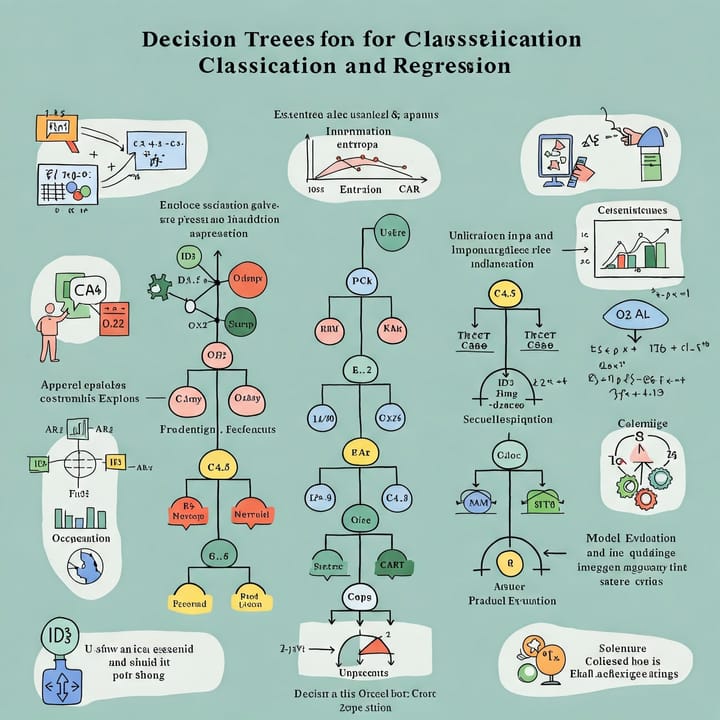From Zero to AI Hero: Mastering Machine Learning and Deep Learning

Okay, let's outline a learning path for Machine Learning and Deep Learning. This will be a comprehensive roadmap, and you can tailor it to your current knowledge and goals. I'll break it down into stages, covering foundational concepts, core skills, and advanced topics.
I. Foundational Concepts (Prerequisites)
You need a solid base in these areas before diving too deep. Don't skip these!
- Linear Algebra:
- Vectors and Matrices: Operations, linear combinations, span, linear independence, basis.
- Matrix Decompositions: Eigenvalues and eigenvectors, Singular Value Decomposition (SVD), Principal Component Analysis (PCA) - understand conceptually, even if the full derivation is tough at first.
- Inner Products and Norms: Understanding distances, projections, and how they relate to similarity.
- Resources:
- 3Blue1Brown - Essence of Linear Algebra (YouTube series) - Highly recommended for visual intuition.
- Gilbert Strang - Linear Algebra and Its Applications (textbook) - A classic, more rigorous approach.
- Khan Academy - Linear Algebra - Good for building foundational skills.
- MIT OpenCourseware 18.06 Linear Algebra (video lectures) - Excellent in-depth lectures.
- Calculus:
- Derivatives and Integrals: Understand what they represent (rates of change, areas under curves).
- Chain Rule: Crucial for understanding backpropagation in neural networks.
- Partial Derivatives: Essential for multi-variable functions (which are common in ML).
- Gradient Descent: Understand the concept of finding minima using derivatives.
- Resources:
- 3Blue1Brown - Essence of Calculus (YouTube series) - Visual and intuitive.
- Khan Academy - Calculus AB and BC - Covers the necessary basics.
- MIT OpenCourseware 18.01 Single Variable Calculus (video lectures)
- Probability and Statistics:
- Basic Probability: Events, probabilities, conditional probability, Bayes' Theorem (very important!).
- Distributions: Normal (Gaussian), Binomial, Poisson, Exponential – understand their properties and when they apply.
- Descriptive Statistics: Mean, variance, standard deviation, covariance, correlation.
- Inferential Statistics: Hypothesis testing, p-values, confidence intervals (basic understanding is enough).
- Maximum Likelihood Estimation (MLE) and Maximum A Posteriori (MAP) estimation: Important for understanding how models are trained.
- Resources:
- Programming (Python):
- Basics: Variables, data types (lists, dictionaries, etc.), loops, conditional statements, functions.
- Essential Libraries:
- NumPy: Numerical computation with arrays and matrices. This is fundamental. Learn array operations, broadcasting.
- Pandas: Data manipulation and analysis. Learn to work with DataFrames.
- Matplotlib and Seaborn: Data visualization.
- Scikit-learn: Machine learning library (we'll use this extensively).
- Resources:
II. Core Machine Learning
- Introduction to Machine Learning Concepts:
- Supervised, Unsupervised, and Reinforcement Learning: Understand the differences and key applications.
- Training, Validation, and Test Sets: Critical for model evaluation and avoiding overfitting.
- Bias-Variance Tradeoff: A fundamental concept in model selection.
- Overfitting and Underfitting: How to identify and address them.
- Evaluation Metrics: Accuracy, precision, recall, F1-score, ROC AUC, Mean Squared Error (MSE), R-squared, etc. Choose the right metric for your problem.
- Cross-Validation: Techniques like k-fold cross-validation for robust model evaluation.
- Key Machine Learning Algorithms (Scikit-learn):
- Linear Regression: Understand the assumptions, how to interpret coefficients, and how to evaluate.
- Logistic Regression: For classification problems. Understand the sigmoid function and how it relates to probabilities.
- Decision Trees: Understand how they split data and make predictions.
- Random Forests: Ensemble method using multiple decision trees. Generally very powerful and robust.
- Support Vector Machines (SVMs): Understand the concept of maximizing the margin between classes. Kernel trick.
- K-Nearest Neighbors (KNN): Simple, instance-based learning.
- Naive Bayes: Based on Bayes' Theorem. Often used for text classification.
- Clustering Algorithms:
- K-Means: Partitioning data into clusters.
- Hierarchical Clustering: Building a hierarchy of clusters.
- DBSCAN: Density-based clustering.
- Dimensionality Reduction:
- Principal Component Analysis (PCA): Find the principal components that capture the most variance in the data.
- t-distributed Stochastic Neighbor Embedding (t-SNE): Useful for visualizing high-dimensional data.
- Practice and Projects:
- Kaggle Competitions: Start with beginner-friendly competitions (like the Titanic dataset or House Prices).
- UCI Machine Learning Repository: A great source of datasets.
- Build your own projects: Find a problem that interests you and apply ML to solve it. This is the best way to learn.
- Document your work: Use Jupyter Notebooks to explain your process, code, and results. This is great for building a portfolio.
III. Deep Learning
- Introduction to Neural Networks:
- Perceptron: The basic building block of a neural network.
- Multi-Layer Perceptron (MLP): Feedforward neural networks.
- Activation Functions: Sigmoid, ReLU, Tanh, etc. Understand their properties and why we use them.
- Backpropagation: The algorithm for training neural networks. Understand the chain rule's role.
- Loss Functions: Mean Squared Error (MSE), Cross-Entropy, etc.
- Optimization Algorithms: Gradient Descent, Stochastic Gradient Descent (SGD), Adam, RMSprop, etc. Understand how they update the network's weights.
- Regularization Techniques: L1, L2, Dropout, Batch Normalization – to prevent overfitting.
- Deep Learning Frameworks (Choose one or more):
- TensorFlow (with Keras): Very popular, versatile, and good for production. Keras makes it much easier to build and train models.
- PyTorch: Gaining popularity, especially in research. More "Pythonic" and flexible than TensorFlow.
- Resources:
- TensorFlow Tutorials (on the TensorFlow website)
- Keras Documentation
- Deep Learning with Python (book, by François Chollet, the creator of Keras) - Excellent.
- PyTorch Tutorials (on the PyTorch website)
- Fast.ai (online course and library) - A great, practical approach to deep learning.
- Convolutional Neural Networks (CNNs):
- Image Processing Fundamentals: Basic image operations (filtering, edge detection).
- Convolutional Layers: Understand how they extract features from images.
- Pooling Layers: Reduce dimensionality and make the network more robust to small variations.
- Common Architectures: LeNet, AlexNet, VGG, ResNet, Inception, MobileNet – understand their key features and how they evolved.
- Applications: Image classification, object detection, image segmentation.
- Recurrent Neural Networks (RNNs):
- Sequence Data: Time series, text, audio.
- Basic RNN Architecture: Understand how they process sequential data.
- Vanishing/Exploding Gradients: A major challenge with RNNs.
- Long Short-Term Memory (LSTM): A type of RNN designed to address the vanishing gradient problem.
- Gated Recurrent Units (GRUs): A simplified version of LSTMs.
- Applications: Natural Language Processing (NLP), machine translation, text generation, time series forecasting.
- Other Important Deep Learning Topics:
- Autoencoders: For unsupervised learning and dimensionality reduction.
- Generative Adversarial Networks (GANs): For generating new data (e.g., images).
- Transfer Learning: Using pre-trained models to improve performance on new tasks. Highly recommended.
- Hyperparameter Tuning: Techniques for finding the best settings for your models (e.g., learning rate, number of layers).
- Deployment: How to put your models into production (e.g., using Flask, TensorFlow Serving, cloud platforms).
IV. Advanced Topics and Specialization
- Natural Language Processing (NLP): Word embeddings (Word2Vec, GloVe, FastText), transformers (BERT, GPT), sentiment analysis, machine translation, question answering.
- Computer Vision: Object detection (YOLO, SSD, Faster R-CNN), image segmentation (Mask R-CNN), pose estimation.
- Reinforcement Learning: Markov Decision Processes (MDPs), Q-learning, Deep Q-Networks (DQN), policy gradients.
- Time Series Analysis: ARIMA models, recurrent neural networks for time series.
- Graph Neural Networks (GNNs): For data with graph structures (social networks, molecules).
- Explainable AI (XAI): Making models more interpretable.
- Adversarial Machine Learning: Attacking and defending machine learning models.
Key Learning Strategies:
- Hands-on Practice: Code, code, code! The more you practice, the better you'll understand.
- Start Small: Don't try to learn everything at once. Focus on one concept at a time.
- Read Research Papers: Stay up-to-date with the latest advancements. Start with survey papers and then dive into specific areas.
- Join a Community: Online forums (Reddit, Stack Overflow), meetups, conferences. Learn from others and share your knowledge.
- Build a Portfolio: Showcase your projects on GitHub, Kaggle, or your own website.
- Don't be afraid to get stuck: It happens to everyone. Use online resources (Stack Overflow, forums, etc.) to search for help.
This is a comprehensive learning path. It's a journey, not a sprint. Be patient, persistent, and enjoy the process!



Comments ()